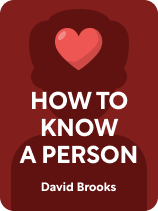

This article is an excerpt from the Shortform book guide to "How to Know a Person" by David Brooks. Shortform has the world's best summaries and analyses of books you should be reading.
Like this article? Sign up for a free trial here.
What’s How to Know a Person by David Brooks about? How can we rebuild connections as human beings?
In How to Know a Person, New York Times columnist David Brooks argues that our ability to truly understand and connect with others is in crisis. Brooks contends that by rediscovering the lost art of “knowing” people, we can bridge divides, foster empathy, and rebuild our moral character.
Read below for a brief How to Know a Person book overview.
Overview of How to Know a Person
In the How to Know a Person book (2023), David Brooks argues that our relationships are in decline—and the morality of our society with them—because many of us have lost touch with a crucial part of being human: our ability to know other people well. Brooks writes that knowing others enables us to see across political divides, racial lines, and geographic distances, allowing us to truly understand one another. To Brooks, learning and practicing the skill of knowing other people is not just a social good, but a moral imperative.
Brooks argues that if you’re too absorbed in your own life and perspective, you close yourself off to the humanity and dignity of the people around you. This leads to a diminished life for you as an individual, as well as a lack of morality and meaning among all people. Brooks sees modern problems like political polarization, the mental health crisis, and an epidemic of loneliness as the consequences of our failure to teach (and learn) the social skills and moral character needed to live well in large, diverse groups.
What Does It Mean to Really Know People?
Brooks writes that many of us feel unacknowledged, unseen, and unloved. But he argues that we feel this way not because nobody cares about us, but because we’ve lost the skill of getting to know one another deeply—and making each other feel known. He contends that we weren’t always missing this vital ability. Instead, there’s a mismatch between the number of people we encounter in our modern world and our brains’ capacity to get to know others. As Brooks points out, we’re still working with social skills that our early human ancestors evolved as they lived in small hunter-gatherer bands. In his assessment, these skills haven’t quite caught up to the demands of the large, diverse societies we live in today.
Brooks explains that modern societies are much larger than the small hunter-gatherer bands that our early ancestors lived in. We also have much more intricate social structures and institutions to organize our communities. Plus, modern technology enables us to interact with people all over the world. All of these layers of interconnectedness add complexity to our relationships—a situation that our evolution in small hunter-gatherer societies hasn’t quite prepared us for. Brooks argues that as a result of the mismatch between the social skills we have and the social skills we need, we don’t feel connected to the people around us, and we often can’t empathize with people who are outside our social groups or who are unlike us.
What would it mean to get around the limitations of our social skills and cultivate the skill of really seeing and knowing other people, as Brooks contends we must? He explains that to really know people, you have to do three things in your everyday interactions, no matter how fleeting they are: See people as individuals, appreciate people’s perspectives and life stories, and recognize every person’s inherent worth as a human being. In this section, we’ll dig deeper into each of these critical skills.
Seeing People as Individuals
Brooks explains that to really know another person, you first have to see them as an individual: a person with a unique set of life experiences, characteristics, motivations, and goals. We know this about other people we meet, in theory—yet most of us form our initial impression of others within minutes of meeting them and don’t take the time to learn much more about them.
Brooks explains that when we fail to learn about the particulars of another person’s life and character, we miss out on the opportunity to see them as complex people with their own full, unique lives. Instead, we stereotype and label others, coming to snap judgments about who they are and how they live their lives. By making assumptions about who someone has been in the past or jumping to conclusions about who they’ll be in the future, we miss the chance to see who they are in the present moment, right in front of us.
Brooks argues that when we rely on easy stereotypes and quick judgments, we show a lack of curiosity about other people—and he notes that the people around us can see that lack of curiosity. We’ve all met somebody who’s treated us as just another tool they can use to get what they want, or as an obstacle standing between them and what they hope to achieve. We don’t like feeling our individuality and humanity minimized. But that doesn’t stop us from dismissing others in the same way, and it doesn’t feel good for us or for them.
Appreciating Different Perspectives and Life Stories
A second strategy that Brooks considers vital for truly understanding people is to learn to look at others and appreciate the depth and merit of their perspective. Brooks points out that we live in diverse societies filled with people who are similar to us in some ways and different from us in others. But we have no hope of really knowing people who are different from us if we can’t learn to value the diversity of points of view and experiences that others bring with them.
Brooks contends that when people feel isolated, they turn to social groups like political parties to find meaning and to establish their identities. But this coping mechanism doesn’t really work: We can’t build real connections with others by defining ourselves with political parties that tend to dehumanize and demean their opponents. Brooks explains that we need ways to connect with others that get us to appreciate rather than fear differences of opinion.
To build this appreciation for ways of thinking and living that are different from yours, you have to learn to see things from other people’s points of view, according to Brooks. That helps you to understand them better. But it does more than that: When you make a point of engaging with people and listening to what they have to say, you can also help them feel respected, which is a rare experience for many of us.
Recognizing People’s Inherent Worth and Dignity
To get to know someone deeply, the third step you need to take is to recognize each person’s great worth as a human being. Brooks emphasizes that this is crucial even when you’ve just met a person or expect to never see them again. He writes that you should remind yourself that each person you interact with is a complex individual worthy of your respect and empathy—something we can lose sight of as we go about our busy lives.
Brooks offers one strategy you can use to remind yourself of people’s inherent worth. He explains that even if you don’t believe that people possess something like a soul, it can help to interact with them as if they do. Whatever your beliefs, the goal is to engage with others with deep respect: to understand that each person has value and dignity.
If you want to really understand other people, you can’t settle for just knowing the basic facts about someone’s background or experiences, according to Brooks. While it doesn’t hurt to know some details on their interests, career, life story, or personality traits, this knowledge is only surface-level.
Brooks says it’s just as important to have a deep understanding that everyone deserves to be respected and appreciated for who they are. He explains that you can use this understanding to recognize and empathize with the unique qualities, struggles, and perspectives of each person you meet. In other words, you can only give people the kind of attention they deserve—the kind that says you see them as a unique and valuable person—if you recognize them as worthy of your time, effort, and respect.
Why Is Learning to Know Others Important—and Difficult?
Brooks argues that we often don’t make an effort to get to know each other, but why is it so vital to our well-being, as individuals and as a society, that we make this effort? According to Brooks, there are two reasons: Knowing other people is a moral act that helps us develop our character as individuals, and it’s a social act that can help us reverse some of the negative changes that the modern world has brought to our communities and how we relate to each other. In this section, we’ll take a closer look at both of these ideas.
How We Treat Others Defines Our Moral Character
First, Brooks considers the effort of getting to know other people a fundamentally moral act. He characterizes the time, attention, and skill you put into seeing and understanding other people as an indicator of the kind of person you are. Morality consists of the small things you do every day, according to Brooks. So he believes we should be present with other people, make an effort to understand them in the context of their lives, and strive to always treat them well.
When explaining the moral importance of knowing others, Brooks notes that the goal isn’t just to understand them, but to be understanding of what they’re going through. Brooks explains that to understand someone is to grasp what they’re thinking or feeling. But to be understanding of someone means going a step further: offering empathy, acceptance, and consideration for what they’re experiencing in the present moment. He explains that according to philosopher Iris Murdoch, extending this kind of understanding and empathy to others is a crucial moral task because the tone of our interactions with each other in these everyday moments forms the substance of our character.
Knowing Each Other Can Help Us Build a Better Society
In addition to seeing the work of getting to know other people as a moral act, Brooks characterizes it as a profoundly social act. He explains that knowing other people can help us repair some of the problems that drive people apart. And when we strengthen our relationships as individuals, that can help us reinforce our society as a whole. Brooks emphasizes that it’s imperative to our survival to fix the problem of not relating to each other.
When you look around, you can see that many people struggle with a sense of loneliness, isolation, and distrust of other people. This can lead to bitterness, animosity, and even violence. Brooks contends that divisions over differences in race, ideology, and socioeconomic background—along with a lack of understanding and empathy for those differences—wear away at the fabric of our communities. When we’re unable to relate to each other or communicate effectively, we create a culture of hostility and dehumanization. This hurts our ability to work toward common goals and to exercise the trust and respect we need to maintain a healthy, functioning society.
How Can We Better Understand Other People?
While learning to know other people is crucial, Brooks acknowledges that it takes a lot of time and effort to cultivate this skill—and to actually practice it in our everyday lives. But he contends that anybody can learn to know others by mastering three skills: making others feel seen, listening deeply to others, and cultivating social skills that might not come naturally—like stepping outside of our own perspectives, practicing empathy, and recognizing where somebody is in their life’s journey. Next, we’ll examine each of these strategies in more detail so you can learn how to practice them.
Learn to Make People Feel Seen and Valued
Brooks explains that it’s crucial to interact with others in ways that show them you appreciate them and want to understand them. This involves several skills you can practice every day, like being open to what people share with you, learning to be present with others through even the mundane things you do together, and using your conversational skills to deepen your connections with people. Here’s how Brooks recommends doing this in your everyday interactions.
Open Yourself Up to What People Share With You
To help people feel that you value them for who they are, you first have to make it clear that you want to get to know them. Brooks says you can do this by opening yourself up to others’ ideas, experiences, and perspectives. Make a point of listening closely when they share with you: They’ll realize you’re open to what they’d like to share if you’re generous as a listener when they tell you about themselves.
Be Present With People Through Everyday Experiences
A second way to show people you see and value them is to be present in the moments you share with them each day, even when you’re doing something routine. Brooks notes that you probably spend most of your time doing the mundane things that make up everyday life: collaborating on projects with your coworkers, cooking dinner with your partner, driving to school with your kids, striking up a conversation with the neighbors, and so on. He recommends learning to see these moments as chances to engage with the people you share them with: to bring your whole self to those moments and to enjoy seeing how others navigate their lives.
Engage and Improve Your Conversational Skills
A third crucial tool for helping others feel understood is simply to engage them in a great conversation. Brooks explains that you can have compelling, enriching conversations even with people you’re still getting to know. That’s especially true if you make a point of cultivating your conversational skills. To turn everyday encounters into a chance to get to know someone better, you have to hone your ability to listen. Brooks explains that we often fail to really listen to one another, but that’s a bad habit you can break with a little bit of work.
Learn How to Dig Deeper Into People’s Life Stories
Brooks explains that once you’ve begun to cultivate the skills that help you make others feel understood, the next step is to engage fully with the stories that others tell you about who they are, where they’ve been, and where they want to go. In this section, we’ll explore three ways you can do that in your everyday life.
Practice Asking People the Right Questions
Brooks writes that the first step to engaging more deeply in someone’s story is to learn to ask good questions. When you want to discover how someone sees the story of their life, you can’t ask perfunctory questions and expect to get deeply insightful answers in return. For example, Brooks recommends that instead of asking someone what they think about a particular topic, you could ask how they came to think the way they do about that issue.
Brooks contends that, contrary to popular opinion, it’s often OK to ask people big questions: the kinds of questions that we ask as children but get squeamish about posing to each other as adults. He thinks it’s a good idea to ask people questions about what they believe about the world, what kind of person they know themselves to be, and what they value most in their lives. Most people want to tell their story—once you’ve established a trusting relationship with someone, Brooks thinks the chances are good that the other person would welcome a conversation about the big, philosophical questions they rarely get asked.
Help Others See Their Stories (and Themselves) More Clearly
The second step Brooks recommends for going deeper into people’s stories is to engage with those stories with the goal of helping others to tell better stories about themselves. Brooks contends that even as you ask questions to learn the story of someone’s life from their perspective, you can use your perspective to help them see themselves more clearly. We have a natural tendency to arrange our experiences into neat stories. But sometimes, these stories aren’t entirely accurate. Brooks explains that you can pay attention to the ways in which a person’s story doesn’t fully represent who they are or capture the direction their life seems to be going in. Then, you might be able to help them change that story.
Recognize the Influence of a Person’s Culture and History
Brooks’s third step to engaging more deeply with people’s stories is to look for the influence of their culture and personal history on the events and choices they’re telling you about. Brooks says some of the key events in a person’s story began long before they were born: in the history of the place they grew up or in the backstory of the people they’re descended from. He believes our ancestors’ history lives on in all of us. So, to really know a person, it helps to learn where they came from and how it impacted their view of the world and their place in it.
Practice Difficult Social and Emotional Skills
Finally, once you’ve started building your skills in making people feel seen and engaging more deeply with the stories they tell, you can turn your attention to cultivating some social skills that don’t come naturally to many people. Brooks explains that as we practice learning to know others, we often have to work to counter some of our natural tendencies: the tendency to see things in a self-centered way, to be impatient rather than empathetic, or to shy away from the messy parts of others’ lives.

———End of Preview———
Like what you just read? Read the rest of the world's best book summary and analysis of David Brooks's "How to Know a Person" at Shortform.
Here's what you'll find in our full How to Know a Person summary:
- The benefits of really getting to know other people
- How to better understand people on a personal level
- Why our morality and relationships are in a crisis






